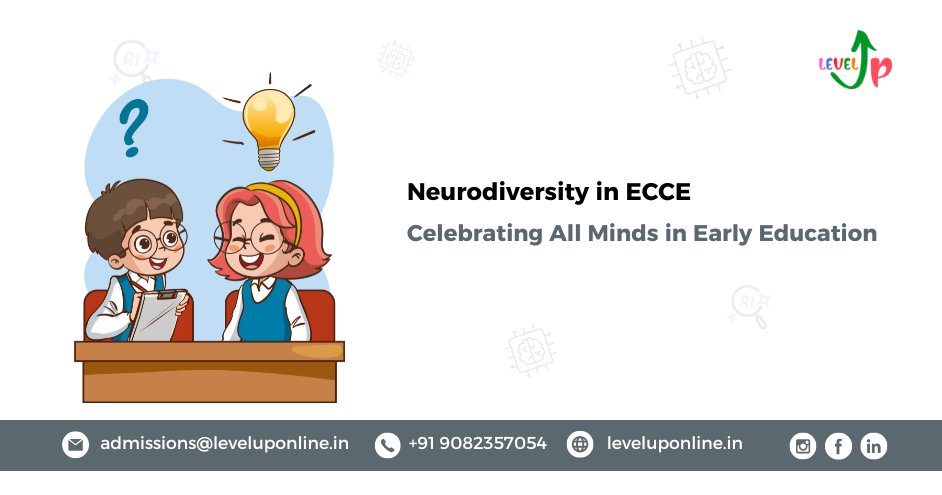Introduction: What is Neurodiversity in ECCE All About?
In today’s world of Early Childhood Care and Education (ECCE), one truth is becoming increasingly clear: not all minds think the same way—and that’s a beautiful thing. That’s the essence of neurodiversity in ECCE. It’s about recognizing that neurological differences such as autism, ADHD, dyslexia, and other cognitive variances aren’t deficits—they’re simply different ways of processing the world. And in early childhood education, embracing these differences can shape more inclusive, creative, and emotionally attuned environments.
🌱 What Does Neurodiversity Mean?
It’s Not a Diagnosis—It’s a Perspective
Neurodiversity is a term that reframes the conversation about how brains work. Coined in the 1990s, it challenges the outdated idea that only one kind of brain is “normal.” Instead, it celebrates the natural variation in how children think, learn, and experience the world.
🏫 Why is Neurodiversity in ECCE So Important?
Early Years = Big Impact
The early years are when a child’s brain is most malleable. Acknowledging neurodiversity in ECCE ensures that we don’t mold every child to fit the same learning box, but instead build a system that adapts to diverse cognitive needs.
Reduces Stigma
When educators and peers understand that different doesn’t mean “less than,” it normalizes diversity, leading to more compassionate classrooms.
🧩 Common Neurodivergent Profiles in ECCE
1. Autism Spectrum Disorder (ASD)
Children on the spectrum might struggle with communication or sensory processing but excel in pattern recognition or creative expression.
2. Attention Deficit Hyperactivity Disorder (ADHD)
Often seen as hyperactive or inattentive, these children are typically fast thinkers and spontaneous problem-solvers when given the right tools.
3. Dyslexia and Other Learning Differences
Dyslexic learners may battle with reading but can be highly intuitive, artistic, or emotionally intelligent.
🔍 Spotting Neurodiversity in the Classroom
Behaviors That Might Be Misread
1. A child who avoids eye contact may not be “rude”—they might be overwhelmed by stimuli.
2. A child who can’t sit still isn’t necessarily disobedient—they may be seeking sensory input.
Recognizing these behaviors as signs of neurodivergent wiring allows for better support, not punishment.
🎨 Inclusive Teaching Strategies That Work
1. Multisensory Learning Approaches
Using visual, auditory, and tactile experiences benefits all children—not just neurodivergent ones. Finger painting, music, storytelling, and movement create layers of understanding.
2. Flexible Learning Spaces
Allow kids to sit on cushions, stand, or use fidget tools. This makes classrooms less restrictive and more accommodating to various needs.
3. Break Tasks Into Chunks
Big instructions can overwhelm neurodivergent kids. Breaking tasks into bite-sized steps makes learning feel achievable.
👩🏫 Role of Educators in Embracing Neurodiversity
Teachers are more than instructors—they’re advocates, observers, and bridge builders. When educators receive proper training in neurodiversity in ECCE, they:
1. Understand different learning and behavioral cues.
2. Avoid labeling kids as “difficult.”
3. Build strong relationships with parents and therapists.
💬 Building Strong Communication with Parents
Open communication with families helps ensure that support for neurodivergent learners continues at home. Create a system of regular check-ins, shared strategies, and honest feedback loops.
📚 Curriculum That Celebrates Every Mind
A neurodiversity-friendly curriculum:
1. Offers varied assessments (not just tests or worksheets).
2. Encourages collaborative activities.
3. Promotes social-emotional learning alongside academics.
The goal isn’t just academic success—it’s to build self-esteem, empathy, and joy in every learner.
🏘️ Creating a Culture of Acceptance
Start with Peers
Model inclusive behavior. Teach all children that:
1. It’s okay if someone learns differently.
2. Kindness is more important than conformity.
3. Everyone has something valuable to contribute.
Language Matters
Swap terms like “normal vs. abnormal” with “different strengths and challenges.” Language shapes perception—let’s use it to uplift, not divide.
🔧 Challenges Educators Face in Embracing Neurodiversity
1. Lack of Training: Many teachers haven’t received specific guidance on how to support neurodivergent learners.
2. Time Pressure: Standardized curriculums often leave little room for personalized attention.
3. Classroom Size: Larger groups make it harder to provide tailored support.
But here’s the truth—small changes make a big difference.
🌍 Real-Life Stories from ECCE Classrooms
1. A non-verbal 4-year-old on the spectrum began expressing himself through dance after his teacher introduced movement-based storytelling.
2. A child with ADHD once labeled as “unmanageable” is now thriving after being allowed to learn through hands-on play and flexible seating.
These are not exceptions. They’re examples of what’s possible when we believe in every child’s potential.
📈 Long-Term Benefits of Embracing Neurodiversity in ECCE
1. Children develop stronger emotional regulation.
2. Inclusive settings build resilience and empathy.
3. Neurodivergent children are more likely to reach their full potential when seen, understood, and celebrated from the start.
🚀 How to Advocate for Neurodiversity in Your ECCE Setting
1. Host awareness workshops for staff and families.
2. Display diverse stories, images, and voices in learning materials.
3. Invite neurodivergent speakers or role models to talk to children.
Every step counts in making neurodiversity in ECCE the norm—not the exception.
🎯 Conclusion: Every Mind Matters
The heart of neurodiversity in ECCE is this: there is no one “right” way to learn, think, or be. By recognizing and embracing these differences early on, we shape a world that values empathy, creativity, and human diversity at its core.
Let’s move away from one-size-fits-all education and toward classrooms that see every child, just as they are, and say—Welcome. You belong here.


